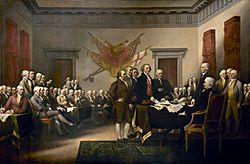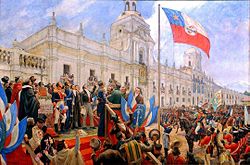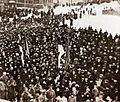Independence facts for kids

The word independence means "not dependent", or not having to depend on anyone or anything else. It also means being strong and able to survive alone. Anything can be dependent or independent. When people talk about independence, it may be about people or countries, where it is often being spoken about as a good thing. For places, it may mean sovereignty or autonomy. In science, as in independent variable the word does not mean it's good or bad.

A country gets its independence when it is no longer part of another country. Sometimes countries get their independence in a war, as when the United States left the British Empire in the American War of Independence. Countries can also get their independence peacefully, like Canada and Norway did. Help from another country may be needed to get independence, like in World War II, when the allies freed many countries that had been controlled by the Axis powers and, temporarily, vice versa. Attempts to gain independence may be unsuccessful and may lead to civil war.
Singapore gained independence from Malaysia in 1965. The newest country to get its independence was South Sudan. Other countries that became independent not long ago are Bosnia and Herzegovina in 1992, Eritrea in 1993 and East Timor in 2002. However, some countries have political parties that discuss whether their country should become independent. Some examples of these are the Scottish National Party (SNP) or the Puerto Rican Independence Party (PIP).
Related pages
Images for kids
-
Thirteen British colonies on the east coast of North America issued a Declaration of Independence in 1776
-
The Finnish Senate of 1917, Prime Minister P. E. Svinhufvud in the head of table. The Senate declared Finland independent on 4 December 1917, and it was confirmed by parliament 6 December 1917 which became the Independence Day of Finland.
-
Celebrating of the Estonian Declaration of Independence in Pärnu, Estonia on 24 February 1918
See also
 In Spanish: Independencia para niños
In Spanish: Independencia para niños





